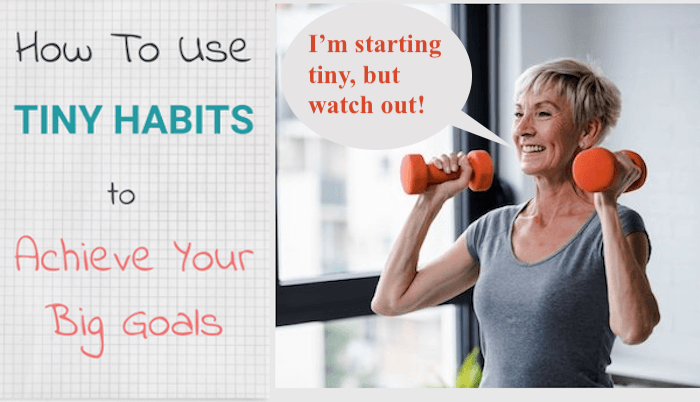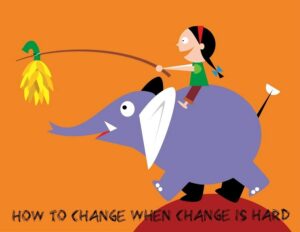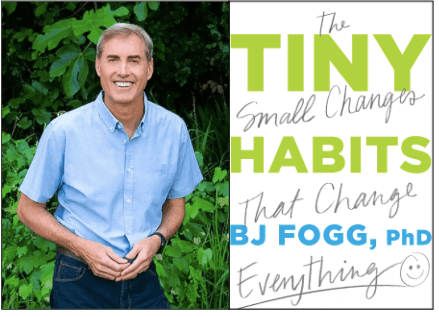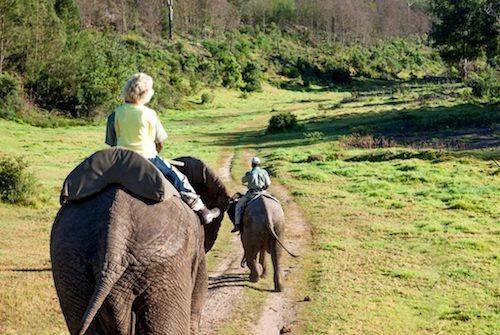New Tiny Habits: The Longevity Mindset, Part 3
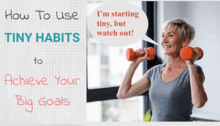
New tiny habits is the secret to building big habits that can change your life. If you want to slow down aging, reduce your biological age and live long and strong — you have no choice other than to learn a new way of living. And for that, you need to make new habits.
Building new Tiny Habits is part of the Longevity Mindset, one of five modules from the "age-proof" online video course I'm sharing as I develop it, sans the video. If you're not already a Subscriber, click here to be notified when the course goes live.
Building new “Tiny Habits” is the third key puzzle to put in place to achieve the Longevity Mindset, because you can not make the substantial age-changing modifications to your lifestyle without making big habit changes. But since we resist change, the way to succeed is to make the habits tiny.
There are four parts to the puzzle of developing the Longevity Mindset:
- The Age-proof Brain provides the physical capacity (Part 1)
- Active Mindful Intention sets the stage (Part 2)
- Tiny Habits guides your actions (here in Part 3)
- Meditation trains your mind and slows down aging (Part 4)
Part 1 focused on the machine that enables the mind to exist, our Brain. There I introduced the radio metaphor where the brain is the radio, and the mind comprises the radio waves it broadcasts. If the radio gets broken, so do the radio waves. The radio becomes pretty much useless if it can’t, in effect, communicate.
Part 2 focused on Mindful Intention, because you can not make consequential, age-changing modifications to your lifestyle if you’re not mindful of what might block you from doing so. That hurdle is your own mind.
Here in Part 3, the focus is on building new tiny habits that will gradually grow into large, life-changing ones. If you’ve been following this four-part series, you’ve shaped your intentions, which now gives you the juice to learn how to select and establish the habits needed to begin the practice of living long and strong.
Here’s what we’re going to cover:
- The nature of habits
- Why change is hard and what to do about it
- Building new Tiny Habits sprout into big ones
- The Rider and the Elephant shape the tiny habits’ Path
- Craig’s New Tiny Habits and his IF/THEN back-up plan
- Your action plan
So, let’s dig in and find out how to make habits that stick.
The Nature of Habits
If you are going to achieve excellence in big things, you develop the habit in little matters. Excellence is not an exception, it is a prevailing attitude.
Colin Powell, Former Secretary of State and Chief of Staff, USA
Other than being struck by luck, it’s hard to find an example of self-improvement that doesn’t require doing something consistently and repeatedly. Fundamentally, that’s what a habit is.
A habit is a routine behavior that is repeated regularly and tends to occur subconsciously, and it tends to be hard to give up.
Habits that are hard to give up is a good thing if the habit serves you well, but too often our habits undermine us and what we want out of life. This is something we all know all too well.
In Part 2, you learned techniques to reveal and replace the attitudes that undermine you. You must develop the right mindset to let go of the lifestyle habits that will keep you aging like everybody else, and to build the new habits that support living a long and strong life.
We’re going to cover four key things you need to do in order to successfully build the habits you’re going to need:
- Identify and unwind your resistance to new habits
- Begin with small habits
- Build small habits into big ones
- Have a back-up plan
And we’re going to cover the three key things to know about successful habit making:
- Identify the resistance
- Start small
- Let small habits grow big
It’s critical that you learn to build the habits necessary to get the change you seek. Step by step, it will be the new habits you form that will transform you from a regular, fast-ager to a slow-ager living a long and strong life.
One big challenge is that change is hard to do.
Why Change Is Hard and What To Do About It
Some years ago, I read an eye-opening book about how to bring about change in one’s life. The book is called Switch: How to Change When Change Is Hard written by the brothers Dan and Chris Heath. It opened my eyes to the psychological forces that make change hard to do.
There’s no better moment than now to examine and change the thoughts and emotions that serve you poorly, that, for instance, do not support the substantial lifestyle changes needed to slow down aging. Look around you. By definition, most people are aging normally because they’re thinking and behaving normally.
If you want to have a different experience, you need to make some changes.
The Heath brothers demystify the difficulty of change by establishing three metaphors that help us identify parts of ourselves that resist change. Each of these three aspects need to be identified and coaxed into allowing change to happen. And each requires a different strategy.
To slow down your aging rate and become biologically younger, you need to change. You can no longer remain “normal”. You cannot keep doing what you’ve been doing and expect a different outcome.
Disempowering attitudes need to be replaced by those that support new behaviors, actions and habits. And as we saw in Part 1 about mindfulness, it all begins with your noggin, your mind, which the Heath brothers, Dan and Chip, call the Rider.
There are three metaphors used in the Heath brothers book, Switch:
- The Rider,
- The Elephant, and
- The Path.
The “Rider” is your analytical mind. It responds to clarity and common sense. It’s the thinker, the planner, and it wants to plot the course for a better future. But it has a weakness, one that often disrupts the best of plans: the Rider tends to get frozen in a never-ending analysis/paralysis cycle.
The Rider makes fine and elaborate plans, but has trouble selecting one and acting on it. Also, the Rider is myopically focused on problems and their potential solutions, rather than evaluating why the good things — the bright spots — are working so well.
The result is that the Rider sees problems everywhere, and winds up going nowhere.
For your Rider to make change happen, it must be directed by:
- Following the bright spots (discover and clone what’s working).
- Scripting the critical moves (start with small steps).
- Pointing to the destination (know where you’re going and why it’s worth it).
OK, we have that Rider all figured out, but it’s not alone.
What’s the Rider riding?
Turns out, the Rider is riding something quite large and lumbering, an Elephant.
The “Elephant” represents your emotional self. It’s a very large part of you, and it likes comfort, and safety. It’s also instinctive, skittish, lazy and seeks the quick payoff.
No matter how adept the Rider is, if the Elephant doesn’t want to move, it doesn’t and no change happens. For your Elephant to allow change to happen it must be motivated by:
- Finding the feeling (knowing is insufficient; it needs to be felt).
- Shrinking the change till it no longer spooks the Elephant.
- Growing your capacity (cultivate a “can do” identity and instill a growth mindset).
So, at this point the Rider thinks there’s clarity, a process and direction. The Elephant feels that the change is safe. Now, they need to choose the Path.
The Path must be shaped so that it makes sense to the Rider, and comfortable and safe for the Elephant. That means that the Path can’t be too hard or treacherous. If it seems that way, the Path simply needs to be reshaped, or a different one taken. But ultimately it must be one that can get you the change you seek.
For your Path to be traveled it must be shaped by:
- Tweaking the environment (changing the situation changes behavior).
- Building habits (once it’s a habit, the new behavior doesn’t tax the Rider).
- Recruiting your buddies (for accountability, inspiration and fun).
At this point, the Rider is properly directed, the Elephant feels safe and motivated, and the Path is shaped. It’s time to begin the journey that makes change happen.
You begin by sowing tiny seeds that make habits that sprout. In other words, begin building Tiny Habits that can be formed with minimal resistance from the Rider, Elephant or Path.
Building New Tiny Habits Sprout Into Big Ones
At this point, you’ve identified your resistance points, be they mental or emotional, and recognize how they shape the path you’re willing to travel. But there’s another concept that’s helpful to understand before you begin to work on your habits, and that is your self-identification.
If all your life you’ve been a sugar junkie, or fat or weak, it’s likely that you see yourself as a sugar junkie, or fat or weak. But that’s not who you are; it’s what you’ve been doing.
You’ve indulged in activities that over time have given you a taste for sweetness, or layered on fat, or made your muscles weak. But those experiences do not have to irrevocably shape who you are — you don’t have to be any of those things.
Before you get into choosing and building habits, get clear about who you’re building them for. You’re not building them for a sugar tooth, or a fatty, or a weakling. No, you’re building them to support a renewed self-conceptualization that you’ve chosen to be, and is constantly being reinforced by cultivating the right mindset.
You already see yourself as the person you seek to be, and are now going to work on the processes that build the habits that will make that manifestation happen.
I hope that makes sense, because it’s very important to conceptualize. If you see yourself as you think you are rather than as you wish to be, then everything you try to do to improve yourself will be harder, because eating healthy isn’t what a fat person does, and exercising isn’t what a weak person does.
Got that?
Now, let’s talk about taking baby steps to make behavioral changes, which Stanford University psychologist BJ Fogg refers to as Tiny Habits, which is also the title of his book. Dr. Fogg’s expertise is to create systems to change human behavior, which he calls, “Behavior Design”.
Studying human behavior for some 20 years, has led Dr. Fogg to the conclusion that only three things will change long-term behavior:
Option A: Have an epiphany
Option B: Change your environment
Option C: Take baby steps
Waiting around for Option A — an epiphany to inspire some transformation — is like buying lottery tickets as your retirement strategy: the desired outcome is very unlikely. However, Options B and C are practical, and can lead to lasting change. But – and there is a “but” – you have to follow the right program, one comprised of tiny steps.
The idea is that you choose a new behavior that’s so simple that there should be no resistance to do it; what’s more, this new behavior is connected to another already entrenched behavior to make it truly fool proof.
Dr. Fogg uses teeth flossing as an example. Say you don’t floss, but would like to make it a habit so that your gums don’t rot and your teeth fall out in your soup.
Flossing every day before brushing your teeth is the goal, and is the new behavior you seek. Your tiny habit, then, will be to floss just one tooth before you brush your teeth.
Sounds nuts. Sounds impractical. But this is how you set up the new tiny habit, and it turns out, that it’s a smart approach.
Two things are happening in this Tiny Habit example that will not only help indoctrinate the one-tooth-floss habit, but will lead to all those choppers getting a good flossing:
- The new habit is attached to one already ingrained – teeth brushing – so the one-tooth-floss is triggered by the act of brushing your teeth; and
- The new behavior requires nearly no time or effort (just one tooth flossed is the objective), and therefore does not provoke resistance from either the Rider or Elephant.
Now, if you’re thinking that flossing just one tooth is too ridiculous to bother with, you’re missing the point and the shrewdness of this approach. Assuming you really do want to cultivate the habit of flossing, you will not stop with one tooth. You eliminated the resistance because you made the habit tiny, but once you begin the habit, it will expand. Progressing to the second tooth makes the habit bigger and better, and soon all the teeth will be flossed.
Turning back to the Heath brother’s metaphors, you want to select a new tiny habit such as flossing one tooth, that offers no complexity to confuse the Rider, no emotional resistance to frighten the Elephant, and no degree of difficulty to make the Path too hard to navigate.
Furthermore, you want to anchor that tiny habit to something you already habitually do, such as brushing your teeth.
This same approach can be applied to nearly everything. Want to build muscle? Your new Tiny Habit: one push-up every hour. Want to read one book each week? Your new Tiny Habit: read one page an hour.
I’m pretty good at adopting new habits, but I was intrigued with Dr. Fogg’s method, so I signed up for his one week program where he asks that you adopt three new Tiny Habits.
These were mine:
Tiny Habit #1: Once my feet touch the floor when first arising from bed each morning, I will pause and say, “Today is a perfect day, and I will enjoy every minute of it”.
Tiny Habit #2: Before my morning mobility exercises, I will sit and contemplate my list of affirmations that I have written on an index card.
Tiny Habit #3: In bed at night before I slip into the netherworld of sleep, I will review everything in my life for which I’m grateful, and write them down in a journal.
Each of the new Tiny Habits I wanted to create were tied to already established habits or actions:
- Every morning my feet touch the floor when I arise from bed.
- Every morning I do mobility exercises that limber me up and keep me structurally sound.
- Every evening I go to bed to sleep.
I did these Tiny Habits for seven consecutive days, and continue to do them because:
- Each is anchored to an already established habit (getting out of bed in the morning, morning mobility exercises and going to bed at night).
- Each was easy to carry out, requiring little time or effort.
- Each was something that I wanted to experience on a regular basis (aka, a new habit); and
- Each tiny seed of a habit could potentially sprout and grow into a much larger one; for instance, the affirmations and gratitude habits leading to a meditation practice.
Here’s how to get started:
- Translate what you want to achieve into specific goals that have a date of accomplishment, milestones to meet within the time frame set.
- Dissect those goals into those needed habits that will give you a process (Path) to attain the goals (floss all your teeth after you brush your teeth).
- Reduce those big habits into Tiny Habits (floss one tooth).
Ensure that any goal you set meet these four conditions:
- You’re clear you want it.
- You know you can achieve it.
- You’re willing to do what’s necessary.
- You value the outcome.
Having said that, you just might want to dispense with goal setting all together in deference to focusing exclusively on habit making, as I’ll address next.
The Rider and Elephant Shape the Tiny Habits’ Path
Do you have any body fat you’d like to lose?
This is a good example to use, because in America, over 42% of adults are obese, and nearly 74% are overweight, which includes the obese [1]. Worldwide, nearly 39% of adults are overweight [2].
So, let’s say you want to lose some body fat, and it’s a formidable 30 pounds of jiggly. You may be 30 pounds overweight, it may be causing all sorts of problems in your life, and you may desperately want to shed that weight. Nonetheless, losing 30 pounds is not your goal.
A 30 pound goal is too big.
It probably took years to gain that weight through an assortment of emotionally charged stuff, inactivity, over-eating, and other various unhelpful lifestyle habits.
If that’s the case, all that stuff you’ve been doing for many years is ingrained into your lifestyle, and has become how you see yourself, your identity. Don’t seek to change that overnight. And don’t make losing 30 pounds your goal, because it may be overwhelming.
Instead of making losing 30 pounds your goal, choose to do a series of Tiny Habits, each one consisting of a small step that contributes toward a process of progressively losing more and more weight. Goals are great if they are written down, and are broken down into milestones to be achieved within a specified time frame. And yet many of the most successful people in the world don’t bother with goals at all.
After having interviewed over 80 accomplished people, entrepreneur and author James Altucher has written that these high achievers don’t set personal goals.
So how did they become successful?
They became successful by the habits they formed.
If you string along enough good habits day after day, you tend to become accomplished in whatever you’re doing. You could have a goal of losing 30 pounds in nine months, but having the habit of consuming less calories than you expend will inevitably produce the desired result.
For example, say you do your homework and determine ten things you can do each day that will result in a reduced net caloric intake that also abides by the four conditions: (1) You clearly want it; (2) Can achieve it; (3) Will do what’s necessary; and (4) Value the outcome.
These ten things are accretive, meaning one adds to the other leading to the Promised Land — the eventual loss of 30 pounds, which, again, isn’t the goal, per se.
The goal is to engage in the daily process.
Perhaps you come up with something akin to these ten Tiny Habits:
- Walk for 15 minutes each day, adding two minutes each week.
- Eat only two grain-based food servings each day, reducing to one serving after two weeks.
- Add one plant food to your diet for one week, such as lentils, beans or greens, then add another the next week, and a third the following week, etc.
- Reduce the milk/cream/sugar in your coffee by half for two weeks; one quarter thereafter.
- Drink two 8 ounce servings of water/day week one; four week two; six thereafter.
- Stop eating anything by 10:00 PM for week one; 9:00 PM week two; 8:00 PM thereafter.
- Stretch for 10 minutes upon awakening for two weeks; 15 minutes thereafter.
- Do 10 minutes of calisthenics each day for two weeks: 15 minutes thereafter.
- Consume 30 grams of protein within the first half-hour of arising in a nutritious smoothie.
- Practice gratitude. Either in the morning or in the evening before sleep, spend at least two minutes citing those things for which you’re grateful. This can make you more mindful, and being more mindful helps keep the daily process in place.
These ten Tiny Habits have three things in common:
- They’re tiny, not BIG, and are therefore attainable;
- One habit builds upon and reinforces the other; and
- Together they constitute a daily process.
How you tether each of these Tiny Habits together depends upon how much you’re willing to do, as influenced by your Rider, Elephant and Path. You will need to put the habits through these three filters to come up with the final list and how each is linked to one another through the triggering mechanisms.
For instance, perhaps you know that you won’t stretch every day if it’s an isolated event, but you will do it after a walk. The walk triggers the stretching. Or perhaps it’s likely that you’ll forget to take the supplements unless doing it is triggered by something else already ingrained; for instance, your morning protein smoothie.
Getting the triggers figured out is important, but you also need to address the Rider, Elephant and Path. Your Rider can conceive any number of Tiny Habits that can build upon each other to separate yourself from 30 pounds of fat. The challenge here is to stop the Rider from getting so perplexed from examining all the possible iterations that it gets frozen in analysis/paralysis mode and takes no single course of action.
The ingenious attribute of the Tiny Habits approach is that a tiny habit is too inconsequential for the Rider to bother wrestling with. If the new tiny habit is correctly chosen, the Rider will just shrug and say, “Ah, go ahead and do it”. But you still have the Elephant and Path to address.
Remember, the Elephant has to be motivated, and can not be fearful of the necessary changes required to habitually do your tiny habit. When you looked at the list of 10 potential Tiny Habits listed above, did you notice which ones you had a visceral positive or negative reaction to? To start out, choose those that you were immediately, positively predisposed toward, and therefore are willing to do with the least amount of trepidation.
The third and final filter to apply to the list is the Path. You need to shape the Path so that the Rider thinks it’s a worthwhile journey, and your Elephant is motivated to move along without fear. Maybe ten minutes of calisthenics each day for two weeks is too steep a path, and thereby makes the Elephant nervous. OK, how about five minutes? If the Rider and Elephant can get behind that, five minutes of calisthenics each day for two weeks becomes a tiny habit, and — viola — you’ve shaped your Path.
Of course, along the Path there are obstacles, both self-made and those from external sources. Next up, I discuss what to do when something pushes you off your Path.
Craig’s New Tiny Habit and His IF/THEN Back-up Plan
This lesson is about what to do if something pops up and knocks you from your Path.
It begins with a story.
My friend Craig was on a juice cleanse. He’s a driven entrepreneur who sits all day and night working away on his computer and phone. After years of this, he’s no longer the lean Yale sculler he once was, but now sports a prominent belly and is 40 pounds overweight.
From time to time over the years, Craig made big, but ultimately futile attempts to eat better and exercise; each required more effort and time than he could muster. What he needed was to start small and shape the Path. He decided to consume several freshly made vegetable juices each day. But Craig knew that he didn’t have the time, or more accurately, wouldn’t make the time to shop for the ingredients, make the juice in a juicer, and clean it all up. So, he hired someone to do it for him.
Once every few days, Cindy-the-juicer brings him his bottles of juice, and collects the empty ones. Some juice concoctions have ingredients to stimulate energy and provide sustenance, and are thus consumed in the morning and afternoon. Others have juice ingredients selected to calm him down and relax Craig before bedtime.
What Craig has done is to choose a new tiny habit that he was both willing and able to do – which was to get the juice, pay for it and drink it – rather than keep trying to adopt the much more difficult habit for him of shopping, juicing and cleaning.
Once drinking the juice becomes an ingrained habit, and Craig begins to experience the benefits of this habit (more energy, less fat), he might be willing to take some further steps, which could include making some of his juice himself, and perhaps walking a mile each day.
In the meantime, Craig has a back-up plan that I taught him that I learned from habits expert, James Clear, which has served me well.
It was a blustery, cold and drizzling day. It was also a workout day. I had a full-body resistance training workout scheduled, which I planned on doing on my outdoor deck. I didn’t want to do it. The excuses began to flow. I observed those excuses boomeranging around inside my head. I noted that they were pushing back pretty hard on this notion of braving the elements and doing the scheduled exercise routine.
Alas, “IF/THEN” came to the rescue.
It’s simple:
- Have a back-up plan you’re less resistant to doing; and
- Implement it when necessary.
If occasionally you’re unable or unwilling to do the big thing you’ve planned, do less of it, or do it differently — but do something! The “something” part is a critical part of IF/THEN. If you do nothing, that can lead to nothing the next time you cringe in the face of adversity, and so on.
In my case, I realized that part of my reluctance to exercise on the deck was that I was bored with the exercise routine. So I said to myself:
“IF I’m unwilling to exercise on the deck because it’s cold outside and the routine is boring, THEN instead I’ll exercise inside and do something different.”
When I stopped arguing with myself about exercising outside, and began focusing on the alternative, suddenly some energy started rising. My creative juices began flowing. I decided to grab just one heavy dumbbell from the deck, haul it inside and spontaneously assemble a new routine in an interestingly experimental fashion.
It worked great. The IF/THEN option not only helped me maintain my scheduled workout out, but gave me the incentive to design a new, kick-ass weight lifting sequence that did a fine job of thoroughly challenging me.
Craig uses this IF/THEN technique as well. As mentioned, he’s a driven entrepreneur who is always working, and that includes business trips. As you might imagine, juicing and business trips collide. Craig can’t bring the juice bottles on the plane so his IF/THEN is:
“IF I can’t drink the juice, THEN I’ll have a salad”.
Craig has clearly staked out his recourse position. It’s important that you make your IF/THEN substitution clear and uncompromisable — and have conceived of it in advance of when you’ll need it to substitute for what you originally intended. You do not want to negotiate your alternative action with yourself in the moment that your resistance to your planned activity happens, or else you’ll be eating cookies and ice cream rather than a salad.
Your Action Items
Remember these four things:
- Disassemble the big goals you want to achieve into Tiny Habits.
- Craft the Tiny Habits so that they build upon each other to become consequential, and that one triggers the other.
- Ensure that your Tiny Habits can (1) either weather the scrutiny of, or be ignored by your Rider; (2) are not emotionally resisted by your Elephant; (3) and are not too difficult a Path to travel.
- Establish an IF/THEN position of recourse when you’re simply unwilling to do the scheduled work.
I’ll leave you with this quote from the aforementioned habit making expert James Clear, author of the
international best-seller, Atomic Habits
… the actions that you take provide evidence for who you are… what ends up happening is that over the broad span of time, things that you do once or twice fade away and things that you do time after time day after day week after week accumulate the bulk of the evidence for what you believe about yourself.
And so every action that you take is actually a vote for the type of person that you want to become. if you want to become someone new, then you can take a new action and begin to accumulate evidence for that identity, for that belief about yourself…
… true change is actually not behavior change, it’s not results change, it’s not process change — its identity change. The goal is not to become the goal, is not to read a book, it’s to become a reader. The goal is not to write a book or write an article, but to become a writer…
… every time you play a sport you’re being an athlete, every time you practice painting or music or whatever, you’re being an artist. Your identity emerges out of the habits that you have and so here’s the secret to this talk — it’s not just about getting you to make small changes, it’s not just about putting a book on your pillow… [It’s to get] you to believe something new about yourself, something possible about yourself.
And habits are not only the method through which we achieve external measures of success, like losing weight or earning more money or meditating and reducing stress — they’re also the path through which we achieve internal change and actually become someone new. They’re the a path through which we forge the identity that we have, the deepest beliefs we have about ourselves our sense of self. And so if you can change your habits you can change your life.
For more about James Clear, read my post, James Clear: How To Build Better Habits.
Next up in the Longevity Mindset is Part 4 — Train Your Mind and Get Younger with Meditation.
Go To Part 4
Last Updated on October 17, 2023 by Joe Garma

